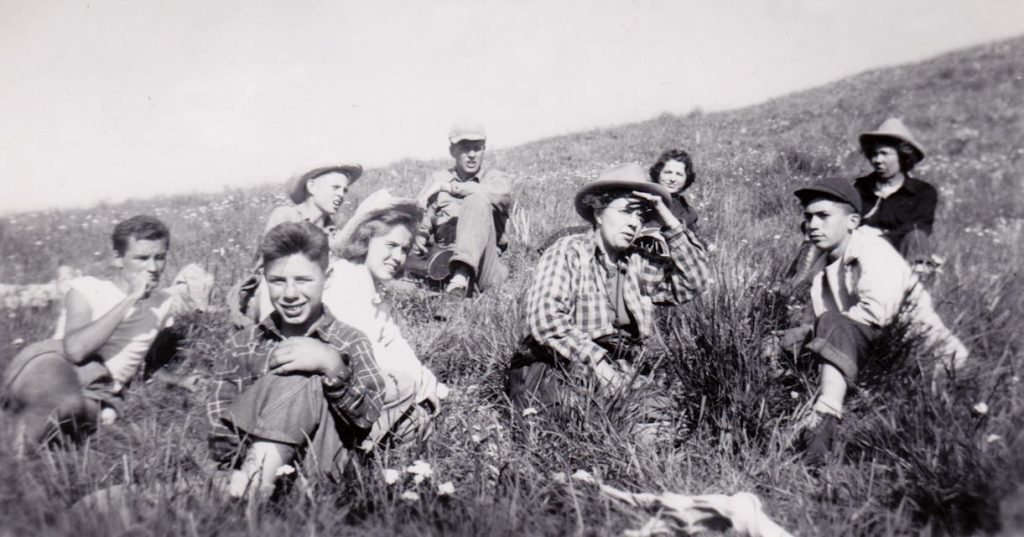Harriet George Barclay, Tributes to a Teacher
Harriet George Barclay, August 31, 1901- May 25, 1990
“She kept saying she couldn’t die because she had too much to do,” recalls retired University of Tulsa biology professor Dr. Paul Buck, for whom Barclay was mentor and friend. … [Until a few weeks before her death] “She was at her computer, organizing data about some 15,000 plant collections—with multiple specimens of each variety—she had picked up from her visits to South America…”
—Dr. Paul Buck, professor, University of Tulsa; obituary, Tulsa World, May 26, 1990
Education
1923 B.A., Botany, University of Minnesota
1924 M.A., Botany, University of Minnesota
1928 Ph.D. Plant Ecology, University of Chicago
1945 B.A. Art, University of Tulsa
Career Highlights
After receiving her PhD under Henry Chandler Cowles, Dr. Barclay taught at the University of Tulsa, OK, for some 43 years, from Lecturer to full Professor. She estimated she spent 18 summers at the Rocky Mountain Biological Laboratory (RMBL), as well as occasional summers or semesters at other colleges.

She was named to Who’s Who in America, Who’s Who Among American Women, and American Men of Science. In 1976, she was named to the Oklahoma Hall of Fame. In addition to the reflections below, Harold Mooney considers Dr. Barclay a significant influence on his career.
From Dr. Jean H. Langenheim, circa 1985:
After Harriet George completed her Ph.D. in 1928, she married B.D. Barclay who also obtained a Ph.D. at Chicago that year, and the couple went to the Botany Department of the University of Tulsa. Harriet joined the faculty in 1929 and taught there continuously until her retirement in 1971. She carried on the Cowlesian tradition of enthusiastically taking students out of the classroom to observe first hand the natural relationships of plants in particular. This was true not only in Oklahoma but at Rocky Mountain Biological Laboratory near Crested Butte, Colorado, where she taught courses in plant ecology and the Rocky Mountain flora for many years between 1929 and 1977 (as she is seen doing in this photo). [HG Barclay in plaid shirt.]
Here and at other field stations (e.g. U. of Oklahoma, U. of Arkansas and No. Carolina State), she provided inspiration for generations of students through her infectious enthusiasm for plant ecology. For example, it was Harriet who influenced me to change my major to Botany and to go to the Univ. of Minnesota to do my Ph.D. with W.S. Cooper, who had influenced her to work in ecology and with his mentor Cowles. Harriet had also infected me with the desire to do both my M.S. and Ph.D. research in plant ecology in the area around the Rocky Mountain Biological Laboratories.
Although Harriet’s greatest impact probably may be as a gifted teacher, she was actively engaged in research. Much of her work in Oklahoma was published in the Proceedings of the Oklahoma Academy of Sciences. Her interest in plants of high altitudes and her love of adventure led her at age 57 to take leave from the Univ. of Tulsa to study alpine plants of Colombia, Venezuela and Ecuador. Her extensive collection of Andean plants greatly increased the knowledge of the flora of that region and she later lectured widely on this research. She subsequently traveled to many other parts of the world, including East Africa, Australia, New Zealand, India, and Nepal, among others.
She was also an accomplished artist and was known both as a painter and photographer of the various areas where she was studying the plants. Because of her devotion to nature, she was a strong leader in conservation, giving unstintingly in locating and preserving unique natural areas in Oklahoma.
Note: This profile is incomplete; more information will be added.
Selected Contributions
1938. A preliminary report of the ecology of a Drosera meadow. Proc. Okla. Acad. Sci, 1938
1938. Luckhardt, RL and HG Barclay. A study of the environment and floristic composition of an oak-hickory woodland in northeastern Oklahoma. Proceedings of the Oklahoma Academy of Science, 1938
1941. Barclay, HG. A subalpine climax grassland in west-central Colorado. Bull. Ecol. Soc. Amer.
1941. Barclay, HG. Plant communities of the Gothic area and their successional relations. Bull. Ecol. Soc. Amer.
1956. Barclay, HG. The Effects of Variation of Wind Direction and Velocity in Oklahoma Sand Dunes: Abstract. Tulsa Geological Society Digest Vol. 24 (1956), Pages 109-110. (Full paper scheduled in the Southwest Naturalist Vol. 1, No. 3, 1956.)
1970. Barclay, HG. The Nature Conservancy’s First Oklahoma Preserve. Proc. Okla. Acad. Sci. 50: 125
References
1985 Barclay, Harriet G. Letter to Jean Langenheim October 1985.
1990. Spaulding, Cathy. Harriet Barclay, retired botany professor, dies Obituary in Tulsa World, May 26, 1990.
2017. Barclay correspondence in JH Langenheim papers: Box 49, Folder 8, Barclay, Harriet 1976-1988. Univ. Calif. at Santa Cruz.